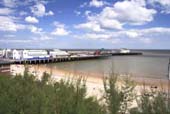Basildon Essex – Basildon is a new town in Essex, created in 1949 after the Second World War, it was intended to house those who suffered due to the bombing in London and the destruction of many of its neighbourhoods. Part of its population comes from East London, near the docks. Basildon was created from four small villages, Pitsea, Basildon, Laindon and Vange. The first reference to Basildon in historical annals is in the Domesday Book, (records of 1086) being referred to as “Belesduna”. Basildon’s name means “the hill” and the words come from Anglo-Saxon, “Beorhtel” and “dun.” Throughout the centuries and in different historical documents, Basildon will be called in different names such as: Berdlesdon, Batlesdon and Belesduna. Within the district of Billericay, we can see a house dating from 1620 where the Pilgrim Fathers met, before emigrating to America on the Mayflower. Basildon today has a population of 185,000, it is situated to the south-east of Brentwood, to the south-east of Billericay and to the north-west of Southend-on-Sea, South Benfleet and Canvey Island.
View a map of Basildon here: http://www.my-towns.co.uk/basildon-map.html
